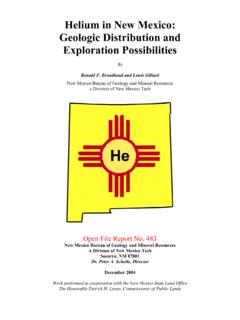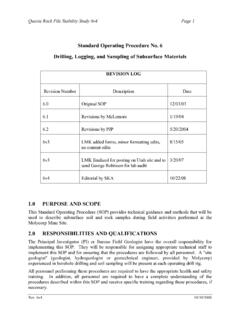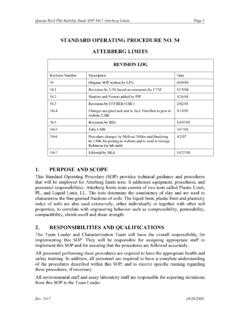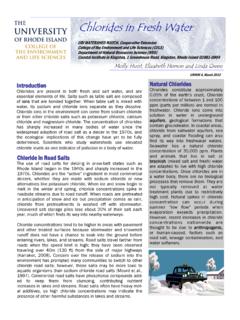Transcription of Brackish and Saline Groundwater in New Mexico
1 water typetotal dissolved solids (tds) in milligrams/liter)commentFreshLess than 500 Typical fresh rangeBrackish1,000 to 10,000As defined by USGSS aline10,000 to 35,000 Seawater is ~35,000 Brine35,000 to 200,000 Oil and gas co-produced waters~500 to over 200,000 Derived from oil and gas productionFully salt saturatedGreater than 250,000 Found in some oil and gas produced waters and deep Saline reservoirsBrackish and Saline Groundwater in new Mexico summer 2 015 Published by the New Mexico Bureau of Geology and Mineral Resources A Division of New Mexico TechNew Mexico meets its ever-growing need for water through both surface and ground- water resources. The supply of surface water is largely dependent upon precipitation, and its availability is therefore subject to periods of drought. Shallow, fresh Groundwater resources supplement the state s water needs, but many of these resources are being used far faster than they are being replenished, and are therefore finite.
2 We know that there are deeper, largely untapped Groundwater resources, but generally these are too salty to drink or to use for irrigation without treatment. Nonetheless, they provide a potential alternative source of Groundwater , and are of increasing interest to the state, particularly as our evolving technologies are providing ways for us to use is water that is found in pore spaces of rock and sediment below the land surface. We know that much of our shallow Groundwater in New Mexico is fresh in quality, and is a good source of drinking water and water for irrigation. However, in many places we encounter saltier water when we drill wells into Groundwater basins. How much salty water is there, and where can we find it? Can we use it during times of drought, or in remote locations that do not have rivers or lakes? Or in applications where fresh water is not required? Will we damage the environment, especially our existing fresh water resources, if we try to use it?
3 In New Mexico , the Office of the State Engineer (NMOSE) characterizes water as being deep non-potable water when TDS is greater than 1,000 mg/L and the water is located more than 2,500 feet below ground surface. This deep water is characterized differently because shallower water is con-sidered to be righted, and has potential for beneficial use, regardless of salinity. This rule is used to protect known fresh water supplies, so that they can be defined in a basin and protected. Even though a water right per se is not assigned to this deeper, saltier water , the NMOSE must be notified when someone plans to drill a well into these zones, in order to manage the basin water supplies and to prevent impingement on nearby fresh of New Mexico s Brackish water Resources Some of the first national-scale studies on Brackish water resources were performed in the late 1950s and early 1960s by the Geological Survey (USGS).
4 These studies have been cited repeatedly since then, because most subsequent water exploration has been focused primarily on fresh water , not salty water . Records were often not kept of the fresh water /salt water interface when water -supply wells were drilled; the drillers seeking fresh water would plug the hole if the water became too salty. The oil and gas industry also drilled through both fresh and Brackish aquifers however, the fresh and Brackish water aquifers did not usually contain economi-cally viable oil and gas deposits, so records of the Brackish water occurrence, depth, and quality were not kept or were not publicly available. Recently, the USGS began to update the national inventory of Brackish water resources, focusing efforts on the Groundwater within 3,000 feet below land surface, with total dissolved solids less than 10,000 mg/L and with the potential for useable water yield.
5 This work is projected to take about 4 years, and it will be most useful to address Brackish water availability at regional or basin New Mexico , there are multiple datasets describing fresh , Brackish , and Saline water resources, however, they are not compiled together to help address the state s current water needs. Much of the pertinent data for New Mexico s Brackish and Saline water resources are held within historic water reports, geologic research reports, or with oil and gas producer s records. In 2003 2004, a Brackish water task force was formed, aiming to character-ize all of New Mexico s Brackish water resources. However, work quickly ended due to the lack of funding. Currently, the New Mexico Bureau of Geology and Mineral Resources, New Mexico Tech s Types of water classified by salinity range as defined by total dissolved solids (TDS) in milligrams/liter (mg/L). new Mexico earth matters 2 summer 2015 Petroleum Recovery Research Center, and the New Mexico water Resources Research Institute, along with other institutions in New Mexico , are gathering information to create a database of all water resources in New Mexico , includ-ing fresh , Brackish , and Saline inventories, as well as produced water quality, quantities, and loca-tions.
6 Work recently completed by the New Mexico Bureau of Geology and Mineral Resources describes the fresh and Brackish water aquifers in the San Juan Basin region (Kelley et al., 2014). The most recently compiled estimates of the quantity of brack-ish Groundwater in New Mexico come from sources such as Feth (1970), Huff (2004), and Hale et al., (1965). Currently, there is no reference that gives adequate or complete volume estimations of Brackish water for the of Brackish water Resources in New MexicoExtensive work over the last 50 years has cataloged basins in the state containing fresh and Brackish water . Significant basins include the Albuquerque Basin, San Juan Basin, Roswell Basin, Capitan Reef Aquifer, Estancia Basin, Mesilla Basin, and Tularosa Basin. In addition, some rivers, streams, and springs or seeps in the state are salty, such as stretches of the Pecos River and the Rio Grande.
7 This is mostly the result of Saline or Brackish Groundwater discharging to the surface, surface water interaction with the underlying geologic as brine concentrate), and to transport the treated water to the point of use. The extraction of deep Brackish waters is much more expensive than extraction of shal-lower fresh water . Pumping costs are much higher, and aquifer permeability is much lower in deep aquifers. Multiple wells may be needed to extract the costs to install a Brackish water treatment facility can be between $10 million and $95 million, depending upon system size. Operations and maintenance can cost $4 million to $6 million per year. Financing, permitting, and energy sources must be acquired. This adds up to about $500 per acre-foot of water delivered above the costs for fresh water delivery. In contrast, the cost for water from a municipal drinking water treatment facility is about $300 per acre-foot delivered from a fresh surface source.
8 The electricity requirement for reverse-osmosis desalination ranges from 3 12 kWh/m3 with electricity costs reach-ing 50% or more of the total cost to desalinate. In sum, desalination is effective but not necessarily the least expensive or most energy-efficient method to improve water supply Impacts of Brackish water UseBrackish water in deep, confined aquifers is, in most cases, not a renewable resource. If we extract this water , eventually the supply will be depleted. Land surface subsidence from Groundwater extraction in the Central Valley of California has reached up to 30 feet. That water cannot be replaced in aquifer storage because of permanent collapse in the aquifer pore spaces. water extraction from shallow Brackish aquifers should not deplete or contaminate fresh water that may be interconnected. Impingement can occur if we withdraw Brackish Groundwater that is interconnected to fresh water by geologic faults or other means.
9 Pumping can entrain and mix the two waters if there is not a sufficient barrier between the aquifers. Barriers are composed of low-permeability rocks or sediments that prevent water flow. Permitting by the NMOSE is implemented to help examine and prevent this mixing and impinge-ment. Sufficient hydrologic studies of the boundaries of a Brackish Groundwater units, or sometimes it is the result of evaporation. Brackish water as a Drought SolutionWith advanced planning and the necessary fund-ing, we can use Brackish water as a supplement to fresh water in times of drought or other shortage situations. This use can improve the lifetime of our fresh water supplies. Because Brackish water will usually need to be desalinated, this means we need to invest in ways to extract (via pumping), transport (via pipelines or trucks), and treat the water ( , using membrane methods like reverse osmosis, or thermal methods like distillation).
10 In 2010, of the 314 desalination plants in the , 95% were inland. Municipal plants were 67% of the total desalination plant capacity, followed by industrial plants (18% of total) (Mickley, 2010). Common municipal applications of desalination include the production of water for drinking, reuse, and recharge. We also need to dispose of the resulting salty waste stream (known Graph of salinity and depth in New Mexico wells. More data exist for freshwater and shallow locations. (Sources: NMBGMR, USGS, NMED). Approximate locations of Brackish water basins of Mexico earth matters 3 summer 2015source are necessary prior to extraction; a clear understanding of nearby fresh water resources also is important. This means that appropriate advance planning and hydrogeological surveys are needed prior to accessing Brackish water aquifers, in order to quantify the risks and benefits of critical environmental issue is the proper handling of Brackish water from the well field to the point of treatment, so as to prevent spills.)



















